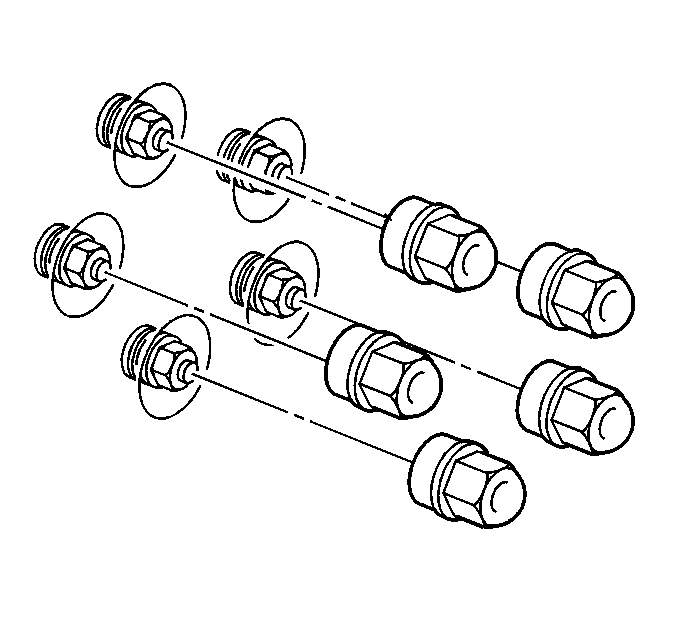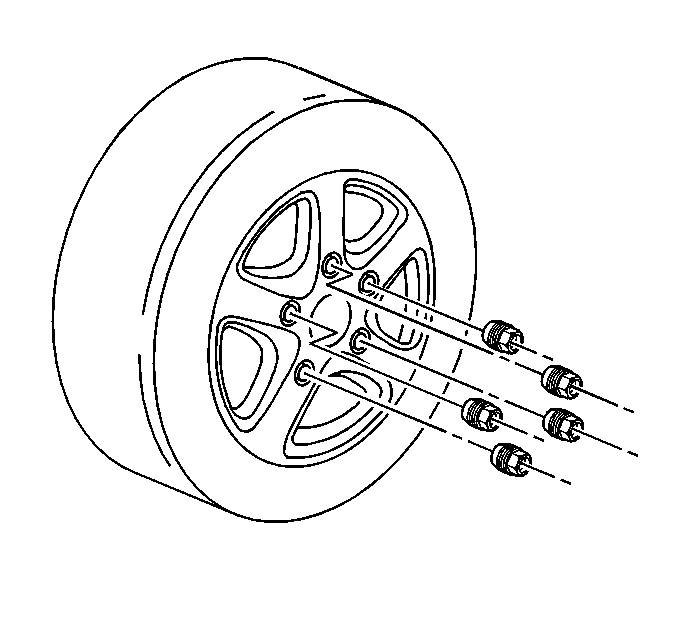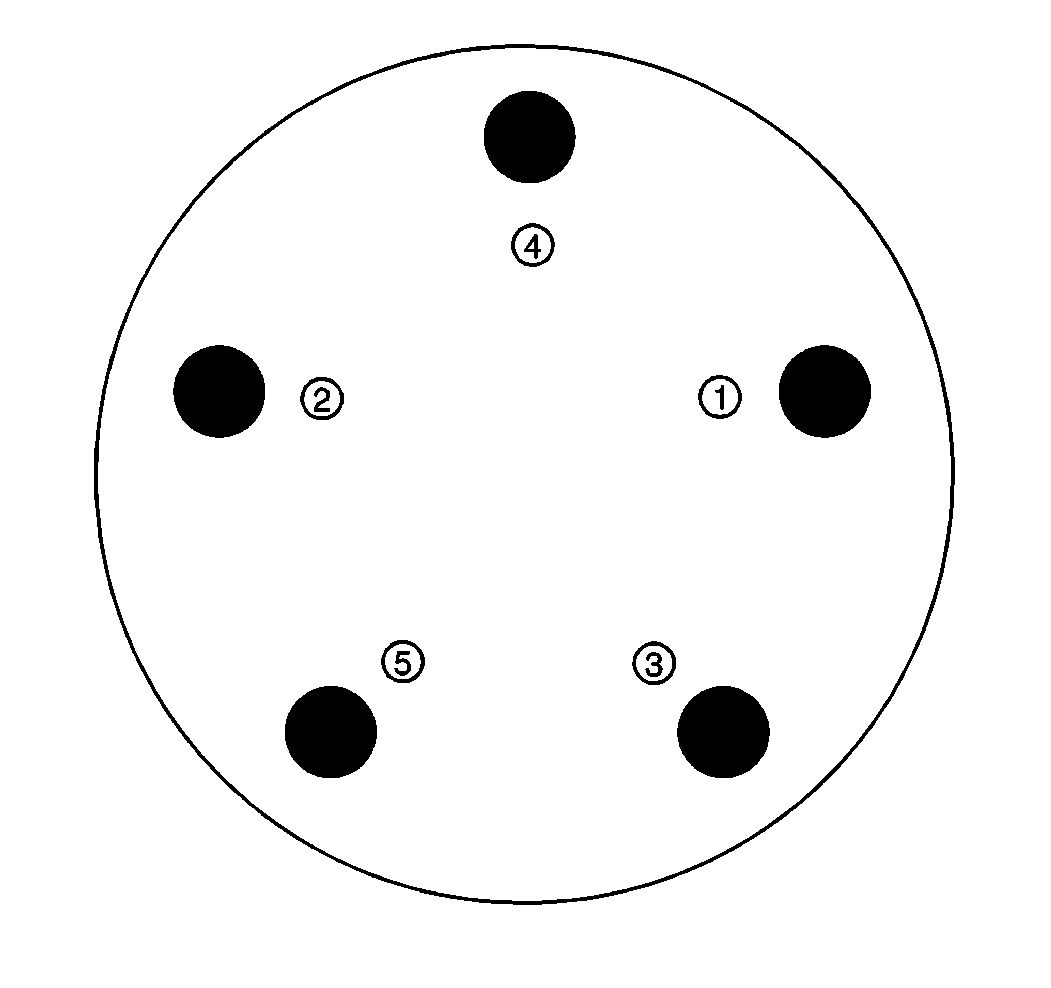Tools Required
J 39544-KIT
Torque Limiting Socket Set
Removal Procedure
- Raise and support the vehicle. Refer to
Lifting and Jacking the Vehicle
.

- Remove the wheel center cap, if equipped.
- Remove the wheel nut caps, if equipped.

- Mark the relationship of the wheel to the hub.
- Remove the wheel nuts.
Caution: If penetrating oil gets on the vertical surfaces between the wheel and the rotor
or drum it could cause the wheel to work loose as the vehicle is driven, resulting
in loss of control and an injury accident.
Notice: Removing the wheel may be difficult because of foreign materials or
a tight fit between the wheel and the hub/rotor. Slightly tap the tire side
wall with a rubber mallet in order to remove the wheel. Failure to follow
these instructions may result in damage to the wheel.
- Remove the tire and wheel assembly from the vehicle. If the tire and wheel assembly is difficult to remove, perform the following steps:
| 6.1. | Install and tighten all wheel nuts on the affected wheel. |
| 6.2. | Loosen each wheel nut 2 turns. |
| 6.4. | Rock the vehicle from side to side. |
| 6.6. | Drive the vehicle forward slightly. |
| 6.7. | Apply the brakes quickly and firmly. |
| 6.8. | Drive the vehicle backward slightly. |
| 6.9. | Apply the brakes quickly and firmly. |
| 6.10. | Repeat this procedure, if necessary. |
Installation Procedure

Caution: Before installing the wheels, remove any buildup of corrosion on the
wheel mounting surface and brake drum or disc mounting surface by scraping
and wire brushing. Installing wheels with poor metal-to-metal contact at the
mounting surfaces can cause wheel nuts to loosen. This can cause a wheel to
come off when the vehicle is moving, causing loss of control and possibly
personal injury.
Important: Wheel nuts, studs, and mounting surfaces must be clean and dry.
- Remove any corrosion or foreign material from the wheel and the hub mounting surfaces.
- Clean the threads on the wheel studs and wheel nuts.
- Install the tire and wheel assembly. Align the locating mark of the wheel to the hub.
- Install the wheel nuts.
Notice: Refer to Fastener Notice in the Preface section.

Notice: A torque wrench or J 39544 must be used to ensure that wheel
nuts are tightened to specification. Never use lubricants or penetrating fluids
on wheel stud, nuts, or mounting surfaces, as this can raise the actual torque
on the nut without a corresponding torque reading on the torque wrench. Wheel
nuts, studs, and mounting surfaces must be clean and dry. Failure to follow
these instructions could result in wheel, nut, and/or stud damage.
Important: Tighten the nuts evenly and alternately in a cross or star pattern, in order to avoid excessive runout.
- Using the
J 39544-KIT
, tighten the wheel nuts in a cross or star pattern.
Tighten
Tighten the nuts to 140 N·m (100 lb ft).

- Install the wheel center cap, if equipped.
- Install the wheel nut caps, if equipped.
Tighten
Tighten the caps to 5 N·m (44 lb in).
- Lower the vehicle.
Special Tools
J 39544-KIT Torque Limiting Socket Set
Removal Procedure
- Raise and support the vehicle. Refer to
Lifting and Jacking the Vehicle.

- Remove the wheel center cap, if equipped.
- Remove the wheel nut caps, if equipped.

- Mark the relationship of the wheel to the hub.
- Remove the wheel nuts.
Warning: If penetrating oil gets on the vertical surfaces between the wheel and the rotor or drum it could cause the wheel to work loose as the vehicle is driven, resulting in loss of control and an injury
accident.
Caution: Removing the wheel may be difficult because of foreign materials or a tight fit between the wheel and the hub/rotor. Slightly tap the tire side wall with a rubber mallet in order to remove
the wheel. Failure to follow these instructions may result in damage to the wheel.
- Remove the tire and wheel assembly from the vehicle. If the tire and wheel assembly is difficult to remove, perform the following steps:
| 6.1. | Install and tighten all wheel nuts on the affected wheel. |
| 6.2. | Loosen each wheel nut 2 turns. |
| 6.4. | Rock the vehicle from side to side. |
| 6.6. | Drive the vehicle forward slightly. |
| 6.7. | Apply the brakes quickly and firmly. |
| 6.8. | Drive the vehicle backward slightly. |
| 6.9. | Apply the brakes quickly and firmly. |
| 6.10. | Repeat this procedure, if necessary. |
Installation Procedure

Warning: Before installing the wheels, remove any buildup of corrosion on the wheel mounting surface and brake drum or disc mounting surface by scraping and wire brushing. Installing wheels with poor metal-to-metal
contact at the mounting surfaces can cause wheel nuts to loosen. This can cause a wheel to come off when the vehicle is moving, causing loss of control and possibly personal injury.
Note: Wheel nuts, studs, and mounting surfaces must be clean and dry.
- Remove any corrosion or foreign material from the wheel and the hub mounting surfaces.
- Clean the threads on the wheel studs and wheel nuts.
- Install the tire and wheel assembly. Align the locating mark of the wheel to the hub.
- Install the wheel nuts.
Caution: Refer to Fastener Caution in the Preface section.

Caution: A torque wrench or J 39544 must be used to ensure that wheel nuts are tightened to specification. Never use lubricants or penetrating fluids on wheel stud, nuts, or mounting surfaces,
as this can raise the actual torque on the nut without a corresponding torque reading on the torque wrench. Wheel nuts, studs, and mounting surfaces must be clean and dry. Failure to follow these instructions could result in wheel, nut, and/or stud damage.
Note: Tighten the nuts evenly and alternately in a cross or star pattern, in order to avoid excessive runout.
- Using the
J 39544-KIT , tighten the wheel nuts in a cross or star pattern.
Tighten the nuts to
140 N·m (100 lb ft).

- Install the wheel center cap, if equipped.
- Install the wheel nut caps, if equipped and tighten the caps to
5 N·m (44 lb in).
- Lower the vehicle.










